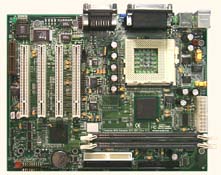Tyan S2054 Tomcat i810 microATX
by Mike Andrawes on August 17, 1999 11:27 PM EST- Posted in
- Motherboards
Those of you into multiprocessor systems "way back" in the Pentium days may remember the i430HX was the primary Pentium chipset from Intel to support SMP. At the time, the i430HX was the latest and greatest from Intel - the clear performance leader over the i430VX.
The Tomcat II board from Tyan was one of the most popular boards to feature the i430HX chipset in an SMP configuration. However, the first versions of the board were plagued with silly problems from erratic CPU speeds to unstable operation and quickly earned Tyan a bad name. But those who got a hold of a late revision of the board knew that Tyan went back to the drawing board with the goal of regaining their reputation and produced a solid revision to the board. But those bitten by the original Tomcat II didn't forget and the Tomcat's bad name lived on.
Fast forward to mid 1999. The latest chipset on the block from Intel is the i810. This time, it's definitely not the clear performance leader with it's integrated i752 graphics. But it is a step forward thanks to Intel's Accelerated Hub Architecture (AHA). When Tyan decided to make an i810 board they finally brought back the infamous "Tomcat" name. While the original Tomcat was one of the most powerful, most expandable, and physically largest boards out there, the Tomcat i810 is quite different.
New Anand Tech Report Card Rating 88/B
| CPU Interface | Socket-370 |
| Chipset | Intel i810 |
| L2 Cache | N/A (on-chip) |
| Form Factor | microATX |
| Bus Speeds | 66 / 100 |
| Clock Multipliers | 2.0x - 8.0x |
| Voltages Supported | Auto Detect |
| Memory Slots | 2 168pin DIMM Slots |
| Expansion Slots |
1 AMR Slot (Shared) |
| BIOS | AMI BIOS Easy Setup Utility 1.16 |
The Good
Whether it's 6 PCI slots on the Thunder 100 and Thunderbolt, the maximum 8 slots on the Tsunami AT i440BX, or the 8 SIMM slots on the original Tomcat II, Tyan has always been known for taking the expansion capabilities of a motherboard to the maximum. With the Tomcat i810, this philosophy has been maintained despite the low cost, minimal expansion nature of the i810 chipset. With an AMR slot a virtual requirement for an i810 board and microATX only featuring four total expansion slots, most microATX i810 boards are coming with 3 PCI slots, 1 AMR and occasionally a shared ISA slot. Tyan decided to go ahead and share the AMR slot (that currently isn't all that useful) with a PCI slot to allow a 4/0/1/0 (PCI/ISA/AMR/AGP) expansion slot configuration - the most possible on a microATX board.
The Tomcat i810 features all the "high end" chips in the i810 family, including Intel's i801AA I/O Controller Hub (ICH) with full Ultra ATA/66 support and the i810-DC100 Graphics and Memory Controller Hub (GMCH) with 4MB 100MHz display cache on the board itself. Two 8ns Samsung 2MB SDRAM chips provide the display cache that handles z-buffering for the integrated i752 found on the i810. Although AnandTech has not encountered any heat issues with the i810 GMCH, Tyan has decided to go ahead and top the chipset with a low profile black heatsink.
Sound is provided by the Analog Devices AD1881 chip that seemingly everyone is using as an AC97 CODEC for host based audio. This will get you by for basic Windows audio, but since it requires the CPU to power it, will slow you down in any audio and CPU intensive tasks - such as gaming. LCD monitor output comes in the form of a small cable that runs from the motherboard to any expansion slot backplate. The interface is DFP and is powered by an onboard Silicon Image SiI154CT64 controller.
Two DIMM slots, the maximum for the i810 chipset, have memory expansion capabilities covered. The layout is clean as we've come to expect from Tyan. All HDD/FDD connectors are located where they should be, right at the front of the board, so that no cables are forced to run over the CPU and/or memory. The ATX power connector is on the edge of the board, right behind the memory slots, which helps to keep the cable clutter down. Backpanel connectors are all color coded for PC99 compliance, while the secondary IDE port can be quickly differentiated by it's white color. No expansion slots are blocked by front panel IO connectors or any other odd obstructions. Although unlikely to be taken advantage of on an i810 board, there is a SCSI LED input set of pins at the front of the board that will allow a single HD activity light to function, regardless of the device in action.
Ten 1000uF capacitors surrounding the CPU socket provide excellent stability - classic Tyan here again. Performance was typical for an i810 motherboard - just like the i440BX motherboards out there, all i810 solutions seem to perform within a few percentage points of each other.











0 Comments
View All Comments